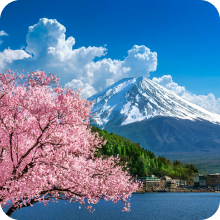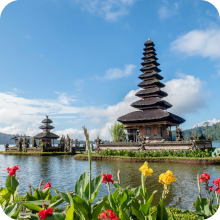Bali's Top Sacred Temples: Must-Visit Spiritual Sites
But with over 20,000 temples on the island, how do you decide which ones to visit? As someone who has explored Bali’s hidden corners for over a decade, I've put together this guide to help you discover Bali's must-visit temples. Whether you're seeking stunning views, cultural immersion, or a spiritual journey, Bali’s temples promise an unforgettable experience.
Table of Contents:
- Introduction
- Bali's Temple Culture and Importance
- Tanah Lot: Bali's Iconic Ocean Temple
- Uluwatu Temple: Perched on a Cliff
- Besakih Temple: The Mother Temple of Bali
- Tirta Empul: A Temple for Purification
- Goa Gajah: The Elephant Cave Temple
- Bonus: Other Must-Visit Temples in Bali
- Temple Etiquette: Do's and Don'ts
- FAQs
Bali's Temple Culture and Importance
Before we dive into the must-visit temples, it’s essential to understand why temples are so important in Balinese culture. Bali is predominantly Hindu, and temples are the heart of spiritual life here. Each temple serves a different purpose—some are dedicated to deities, others mark key natural features like mountains or oceans.
Temples are not only places of worship but also spaces for ceremonies, festivals, and family gatherings. While some temples are small and community-focused, others, like the famous Tanah Lot or Uluwatu Temple, are grand architectural feats that draw thousands of visitors annually.
Tanah Lot: Bali's Iconic Ocean Temple
No trip to Bali is complete without visiting the iconic Tanah Lot Temple. Perched on a rock formation jutting into the ocean, Tanah Lot is one of the most photographed temples in Bali—and for good reason. This sea temple is famous for its stunning sunset views and its cultural significance.
Built in the 16th century, Tanah Lot is dedicated to the sea gods. It's said that the temple’s location was chosen by a Hindu priest who was drawn to its spiritual energy. When you visit, you’ll likely see waves crashing against the rock base while locals perform traditional offerings.
Best Time to Visit Tanah Lot
The best time to visit Tanah Lot is during low tide, so you can walk up to the base of the temple. For photographers and sunset lovers, visiting in the late afternoon offers spectacular lighting as the sun dips into the ocean.
Uluwatu Temple: Perched on a Cliff
Uluwatu Temple is another of Bali’s stunning sea temples, this time perched dramatically on a 70-meter-high cliff. The views of the Indian Ocean crashing against the rocks below are awe-inspiring, making Uluwatu one of the most spectacular places in Bali to watch the sunset.
Uluwatu is dedicated to the spirits of the sea and plays a crucial role in Balinese spiritual life. While the temple itself is relatively small, the surrounding cliffs and coastal scenery are what make Uluwatu so captivating. Don’t miss the traditional Kecak dance performance held here during sunset—it’s a unique cultural experience that adds even more magic to the visit.
Things to Know Before Visiting Uluwatu Temple
- Be mindful of the temple’s resident monkeys—they’re known for snatching sunglasses and snacks!
- The temple can get crowded during sunset, so arrive early to secure a good spot.
Besakih Temple: The Mother Temple of Bali
Located on the slopes of Mount Agung, Bali’s highest volcano, Besakih Temple is known as the "Mother Temple" and is the largest and holiest temple complex on the island. Dating back over 1,000 years, Besakih consists of more than 80 individual temples, including some dedicated to the Hindu Trinity of Brahma, Vishnu, and Shiva.
Besakih’s location is as awe-inspiring as its architecture. With panoramic views of Bali’s lush landscapes, this temple exudes a sense of grandeur and spiritual importance. The annual temple festivals held here draw Balinese Hindus from all over the island for offerings and prayers.
Why Besakih Temple is a Must-Visit
Besakih’s scale and historical significance make it a must-visit for anyone interested in Bali’s religious and cultural heritage. Plan a visit early in the day to avoid crowds and experience the serene atmosphere before the tour buses arrive.
Tirta Empul: A Temple for Purification
If you’re looking for a spiritual cleansing experience, Tirta Empul is the place to go. This temple, located in the village of Tampaksiring, is famous for its holy spring water, which is believed to have healing powers. The Balinese come here to perform a purification ritual, known as "melukat," where they immerse themselves in the sacred water.
The temple itself is beautifully designed, with intricate stone carvings and tranquil pools filled with koi fish. Visitors are welcome to participate in the purification process, making it a unique and immersive experience.
How to Participate in the Purification Ritual
- Visitors must wear a sarong, which can be rented at the temple entrance.
- It’s important to follow local customs, including washing at each spring in the proper order.
Thanks for visiting our blog, are you planing to travel to Bali? Check out our eSIM Bali.

Goa Gajah: The Elephant Cave Temple
Goa Gajah, also known as the Elephant Cave, is a unique temple located near Ubud. Unlike the other temples on this list, Goa Gajah features an ancient cave entrance with an intricately carved stone façade. The cave itself is relatively small but contains several statues and a shrine dedicated to the Hindu god Ganesha.
Outside the cave, you’ll find tranquil gardens, bathing pools, and stone relics scattered throughout the temple grounds. Goa Gajah is an excellent stop for those interested in Bali’s history and archaeology.
What Makes Goa Gajah Unique
Goa Gajah stands out for its blend of Hindu and Buddhist influences, as well as its ancient, mysterious atmosphere. The temple’s quiet and less-touristy vibe makes it a peaceful place to explore.
Bonus: Other Must-Visit Temples in Bali
While the temples above are the most famous, Bali is brimming with smaller, lesser-known sacred sites that are equally worth visiting. Here are a few more to add to your itinerary:
- Pura Lempuyang: Known for its famous "Gateway to Heaven" with Mount Agung in the background.
- Taman Ayun Temple: A royal family temple surrounded by beautiful gardens and lotus ponds.
- Ulun Danu Beratan: A temple on Lake Beratan, famous for its lakeside location and cool mountain air.
Temple Etiquette: Do's and Don'ts
When visiting Bali’s temples, it's important to be respectful of local customs and traditions. Here are a few key things to keep in mind:
Do:
- Wear a sarong and sash (often provided at the temple entrance).
- Be quiet and respectful, especially during ceremonies or prayers.
- Take off your shoes before entering any temple area.
Don't:
- Enter the temple if you are menstruating—this is considered disrespectful in Balinese Hindu culture.
- Point your feet towards the shrines or statues when sitting or taking photos.
- Climb on the temple structures or disrupt offerings.
Check out local government updates before you go!
FAQs
What is the best time to visit Bali’s temples?
The best time to visit Bali's temples is early in the morning or late in the afternoon to avoid crowds and enjoy cooler temperatures. Sunrise and sunset visits also offer stunning lighting for photography.
Are there any entrance fees for Bali’s temples?
Yes, most temples in Bali charge a small entrance fee, typically ranging from IDR 10,000 to IDR 50,000. This fee helps maintain the temples and their grounds.
Do I need to hire a guide when visiting Bali’s temples?
While guides are not mandatory, hiring one can enhance your visit by providing valuable insights into the history and cultural significance of each temple. Many temples offer guides at the entrance for a small fee.















